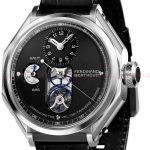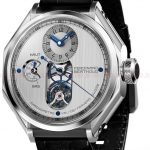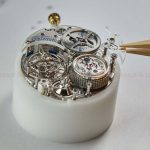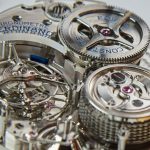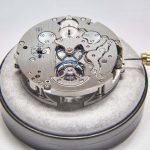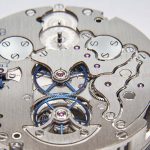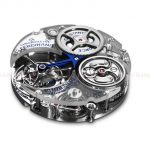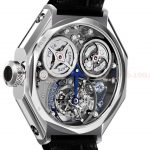Ferdinand Berthoud Chronomètre FB 1.4 in titanio[:en]Ferdinand Berthoud: Chronomètre FB 1.4 in titanio
ESCLUSIVITA’ MECCANICA. I CONCETTI DI LEGGEREZZA E MODERNITA’ SI FONDONO PERFETTAMENTE NEL NUOVO CRONOMETRO FERDINAND BERTHOUD FB 1.4. QUEST’OROLOGIO, CASSA (44 MM) IN TITANIO, CINTURINO IN PELLE E FIBBIA IN TITANIO COMPRESO, PESA SOLO 80 GRAMMI.
Con cassa ottagonale in titanio da 44 millimetri di diametro e meno di 13 millimetri di spessore, il Cronometro FERDINAND BERTHOUD FB 1.4 è la declinazione più leggera del Cronometro FB.
L’orologio, impermeabile fino a 30 metri, è declinato in due versioni di quadrante, nero o argenté e lancette azzurrate. L’orologio sarà realizzato in due serie numerate e limitate a 20 esemplari ognuna.
Le anse, in titanio grado 2, sono fissate alle carrure attraverso due pulsanti stilizzati in titanio brunito da dove parte il cinturino in pelle di alligatore double face nera, cucito a mano con fibbia déployante in titanio a due lame.
Il fondello aperto a vite è dotato di un vetro zaffiro antiriflesso con vista sul movimento.
IL QUADRANTE
Il quadrante è realizzato in ottone microbillé con trattamento galvanico nero e lacca (FB 1.4-1) o in ottone argenté satinato verticale (FB 1.4-2).
Ore e minuti sono decentrati a ore 12 all’interno di un quadrante ausiliario. Quest’ultimo è scandito da numeri arabi indicati da lancette traforate in oro bianco (FB 1.4-1) o azzurrato (FB 1.4-2).
Un’altra finestra del quadrante svela la ruota che porta la gabbia del tourbillon 60 secondi (67 componenti all’interno di una gabbia in titanio di 16,55 mm di diametro, fissata a un arco in acciaio a forma di freccia azzurrata) e la ruota dei secondi, entrambe azzurrate. Al centro si trova, in una posizione inconsueta per un tourbillon, la lancetta dei secondi in bronzo azzurrato. Il ponte del tourbillon a forma di freccia, in acciaio inox, è anch’esso azzurrato.
Sul quadrante, protetto da vetro zaffiro concavo, bombato e antiriflesso, è riportata l’incisione “Chronomètre Val-De-Travers Suisse”. L’autonomia di marcia è indicata da una freccia che punta in corrispondenza delle parole “HAUT” (alto) e “BAS”(basso).
IL CALIBRO
Il suo cuore meccanico pulsante è il calibro a carica manuale FB-T.FC-2. Certificato cronometro dal COSC, è, con i suoi 7,96 millimetri di spessore, il più piatto della sua categoria.
Il movimento sfoggia complicazioni che traggono spunto dai cronometri da marina che Ferdinand Berthoud realizzava nel XVIII secolo e dispone di ponti di zaffiro anglé che, chiusi da pilastri in titanio lucido, oltre a lasciar passare la luce in profondità mettono in risalto l’intero movimento, in particolare la trasmissione a fuso e catena e, per la prima volta, il cono mobile della riserva di carica.
Il dispositivo d’indicazione della riserva di carica, oggetto di una domanda di brevetto, prevede un cono tronco che sale e scende su una vite senza fine, collegata al bariletto. Su questo cono sospeso è collocato un sensore, un braccio che termina con un rubino, la cui posizione sul cono riflette lo stato della carica. Il sensore è a sua volta collegato alla lancetta della riserva di carica, la cui scala graduata “0_1/4_1/2_3/4_1” è incisa sulla stessa platina, azzurrata e visibile attraverso la finestra del quadrante. Sul quadrante l’autonomia è indicata da una freccia che punta in corrispondenza delle parole “HAUT” (alto) e “BAS”(basso).
Particolarità del calibro FB-T.FC-2, con platina, ponti intermedi in alpacca rodiata, grande bilanciere a inerzia variabile (21.600 alternanze/ora) e spirale regolante auto compensatrice realizzata in una lega inossidabile con curva Philips, sono il bariletto e il fuso che sono entrambi rovesciati con la testa rivolta verso il basso e sospesi, mantenuti da un lato solo. Grazie a quest’architettura, oggetto di una richiesta di brevetto, è possibile risparmiare qualche prezioso millimetro.
LA TRASMISSIONE A FUSO E CATENA IN PILLOLE
La trasmissione a fuso e catena rappresenta la soluzione più antica per ottenere una forza costante a livello dello scappamento. Questo sistema agisce come una cassa di demoltiplicazione automatica. Secondo il livello di carica, infatti, la coppia rilasciata dal bariletto varia. Quando il movimento è completamente carico (53 ore di autonomia), la catena si trova interamente avvolta sul diametro piccolo del fuso. La molla del bariletto dispone, a questo punto, della sua potenza massima. La forza diminuisce man mano che il tempo passa mentre la catena si avvolge sul tamburo e passa dal piccolo al grande diametro del fuso. La variazione del diametro del fuso compensa, a questo punto, la riduzione della coppia alla molla del bariletto. Così facendo, lo scappamento riceve un’energia costante a tutto vantaggio dell’equilibratura dell’ampiezza del bilanciere e della precisione cronometrica del movimento.
Quando la molla motrice è associata a un fuso, il tamburo del bariletto ruota in un senso durante la fase in cui la molla si scarica, e nell’altro durante la carica, e ciò garantisce l’avvolgimento della catena. Durante la carica di questo tipo di meccanismo, generalmente il movimento si arresta. Per ovviare a tale effetto, il calibro FB-T.FC-2 è provvisto di un ingranaggio differenziale oggetto di una richiesta di brevetto. Questo permette al bilanciere di continuare la propria oscillazione durante la carica e di conservare le proprietà cronometriche del movimento.
Il meccanismo di carica è provvisto di un pignone di carica a dentatura conica che consente una carica fluida del movimento grazie anche alla generosa corona zigrinata con funzione dinamometrica realizzata in titanio con un medaglione in ceramica nera.
LIGHT AND MODERN. THE NEW WATCH CHRONOMETRE FERDINAND BERTHOUD FB 1.4, INCLUDING ITS STRAP AND BUCKLE IN TITANIUM AS THE CASE (44 MM) WEIGHS JUST 80 GRAMS.
The Chronomètre FERDINAND BERTHOUD FB 1.4, certified chronometer, has an all-titanium case (44 mm x 13 mm) and bright blue detailing.
interpreted in two versions, with a black or silver-toned dial swept over by blued hands, is a lighter version of the Chronomètre FERDINAND BERTHOUD FB 1. The watch, including its strap and titanium buckle, weighs just 80 grams.
This timepiece will be produced in two numbered limited editions of 20 each– a highly symbolic number closely bound up with the history of Ferdinand Berthoud. In 1770, he was awarded the warrant of Clockmaker and Mechanic by appointment to the French King and Navy. He was thus put in charge of inspecting the construction of the timepieces equipping the Royal Navy and received an order for 20 marine clocks (generally known as marine chronometers).
THE CASE
It is a 44 mm-diameter watch, measuring less than 13 mm thick, whose case ensures a natural and comfortable fit on the wrist. Composed of a grade 5 titanium cylinder housing the movement, it comprises two octagonal-shaped sidepieces in polished titanium that contribute to its distinctive shape. The grade 2 titanium lugs are secured to the case middle by two stylised blackened titanium bolts, marking the start of the hand-stitched double-sided alligator leather strap.
For the first time, however, its sides are not pierced with four portholes. The view of Calibre FB-T.FC-2 has been shifted to the back. The light floods into the very depths of the mechanism, since the nickel silver bridges have been replaced by three sapphire half-bridges. Their exceptional rigidity enables them to play this structural role. Their transparency reveals the entire movement, particularly the fusee-and-chain transmission system, as well as affording a first ever view of the polished power-reserve cone.
THE DIAL
The dial of the FERDINAND BERTHOUD FB 1.4 Chronometer is made of black galvanised frosted brass, in the FB 1.4-1 version, or vertical satin-brushed silver-toned brass for the FB 1.4-2 interpretation. Another dial opening reveals the tourbillon carriage driving wheel and the seconds wheel, both delicately blued. The extremely long and slender blued bronze seconds hand is fitted at the centre, an unusual position on a tourbillon model.
The hours and minutes appear in an offset 12 o’clock subdial, punctuated by Arabic numerals combined with cut-out hands in white gold, or blued gold for the FB 1.4-3 version. The nature and provenance of the FERDINAND BERTHOUD FB 1.4 Chronometer can also be read off on this large dial, engraved with the inscription “Chronomètre Val-de-Travers Suisse”.
THE MOVEMENT
The calibre FB-T.FC-2 is an hand-wound movement features 15 nickel silver bridges and three sapphire half-bridges framed by polished titanium pillars surrounding the mechanical organs. This construction is typical of 18th century marine chronometers.
The distinctive nature of the FB-T.FC-2 lies in the fact that its barrel and fusee are reversed, upside down, and above all suspended – meaning they are held on one side only. This helps save a few precious millimetres and contributes to the overall slimness of the calibre. At just 7.96 mm thick, the movement powering the Chronomètre FERDINAND BERTHOUD FB 1.4. is the thinnest in its category.
EQUALISING TORQUE
This movement is one of the rare examples to feature fusee-and-chain transmission, the oldest historical solution developed to ensure constant force for the escapement. This system acts like an automatic gear box, with the amount of torque delivered to the barrel varying according to the level of winding. When the movement is fully wound (53 hours of power reserve), the chain is entirely coiled around the small end of the fusee and the barrel spring is at maximum power. This force dwindles in the course of time, as the chain coils around the drum, moving from the small to the large end of the spindle-shaped fusee. The variation in the diameter of the fusee compensates for the reduction of the mainspring torque. The escapement thus receives constant energy, thereby equalling out the amplitude of the balance wheel and thereby enhancing the movement’s timekeeping precision.
When the mainspring is associated with a fusee, the barrel drum turns in one direction while the spring is unwinding, and in the other during winding, thus serving to coil the chain. During the winding of this type of mechanism, the movement generally stops running. To counteract this effect, the FB-T.FC-2 calibre is equipped with a distinctively designed differential gear, for which a patent has been filed. It enables the balance-wheel to continue oscillating even during winding and thus preserves the movement’s precision timekeeping properties.
The winding mechanism fitted with a pinion featuring cone-shaped toothing, together with a large-diameter knurled crown, enables smooth winding of the movement – a gentle motion that naturally enhances the quality of the rapport established between the watch and its owner, which plays an essential role in the case of a hand-wound watch.
To perfect the security of the movement, the engineers have endowed the crown with a dynamometric function serving to avoid any damage to the movement that might be caused by excessive winding.
THE SUSPENDED MOBILE POWER-RESERVE CONE
A patent has already been filed for the highly sophisticated power-reserve indication device. A truncated cone moves up and down along an arbor connected to the barrel. This suspended cone is topped by a feeler spindle in the form of a mobile arm tipped with a watch jewel. Its position on the cone reflects the state of wind. This feeler spindle is in turn connected to the hand on the power-reserve display, which features blued graduations engraved on the baseplate and visible through a dial opening. For the first time, this ultra-rare device and its exceptional finshing are perfectly visible through the sapphire half-bridges.
THE TOURBILLON WITH CENTRAL SECONDS
Teamed with the seconds wheel and pinion, the tourbillon of Calibre FB-T.FC-2 comprises 67 components assembled within a titanium carriage measuring 16.55 mm in diameter, and fixed to a blued arrow-shaped steel arch. A large variable-inertia balance-wheel is regulated and balanced by four rhodium-plated nickel silver inertia-blocks. It is coupled with a self-compensating regulating balance-spring in a stainless alloy, featuring a Phillips outer terminal curve (overcoil) manually shaped by the expert hands of the women serving as balance-spring fitters at Chronométrie FERDINAND BERTHOUD.
To poise the escapement’s unbalance, two blued 18-carat gold inertia-blocks ensure the uniformity of the weights of this large-size tourbillon.

